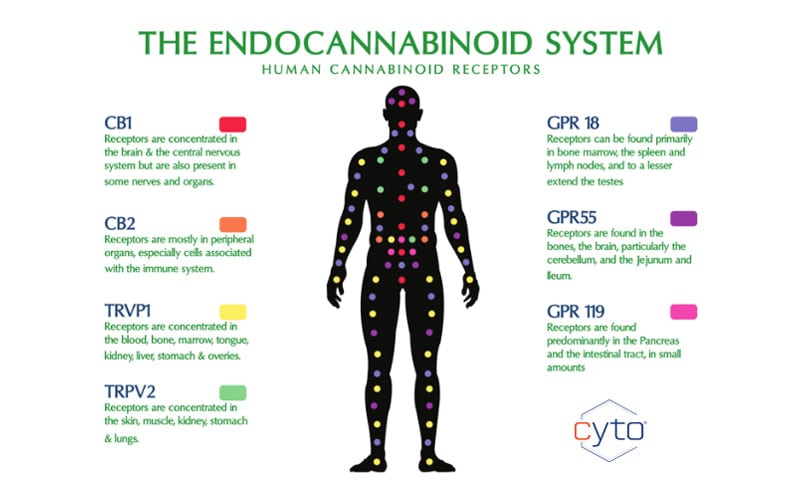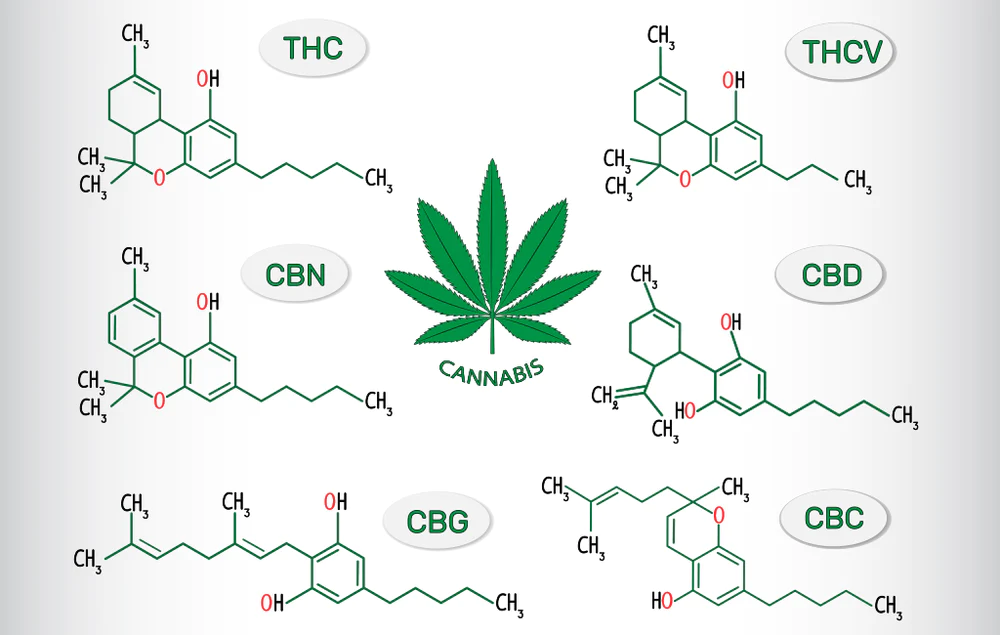Welcome to the Ultimate Cannabinoids Handbook: From the well-known tetrahydrocannabinol (THC) to the lesser-known tetrahydrocannabivarin (THCV) and cannabinol (CBN), research has found that the cannabis plant produces between 80 and 100 cannabinoids. Whether your choice is edibles, extracts, or tinctures, it’s these organic compounds that are behind the known effects of Cannabis.
This guide is your go-to resource, offering in-depth knowledge on:
- Understanding Cannabinoids: Discover what cannabinoids are and how they influence your experiences.
- The Endocannabinoid System: Learn about the crucial system in your body that interacts with cannabinoids.
- Varieties of Cannabinoids: Explore the different types of cannabinoids present in nature.
- Popular Cannabinoids: Get acquainted with the most widely recognized cannabinoids and their unique properties.
- Methods of consumption: get familiar with bioavaibility and the different ways to consume cannabinoids.
Table of Contents
Understand Cannabinoids & Endocannabinoid System (ECS)
Cannabinoids, which are chemical compounds discovered in both cannabis and hemp plants, that interact with the body’s endocannabinoid system upon consumption. This system consists of cell-signaling receptors that are pivotal in managing a range of bodily processes and functions, including:
- Mood regulation
- Immune response
- Appetite control
- Sleep cycles
- Pain sensation
Through their interaction with the endocannabinoid system, cannabinoids can influence these and other important aspects of physical and mental health. The endocannabinoid system (ECS) has been identified in the early 1990s by researchers exploring THC. The system is composed of two main receptors are CB1 and CB2, found all over your body and your brain. These receptors bind with phytocannabinoids and endocannabinoids to signal the ECS to take action. The two main receptors are CB1 and CB2, found all over your body and your brain.
3 Types of Cannabinoids
Cannabinoids are classified into three main types, each originating from different sources and serving unique functions within their respective systems.
- Endocannabinoids: These are naturally produced by the human body to regulate internal functions and maintain balance. Key examples include anandamide (AEA) and 2-arachidonoylglycerol (2-AG), which play crucial roles in mood, pain, and appetite.
- Phytocannabinoids: Derived from cannabis and hemp plants, these external cannabinoids interact with the body’s endocannabinoid system. The most recognized are tetrahydrocannabinol (THC) and cannabidiol (CBD), affecting mood and pain without the psychoactive effects of THC.
- Synthetic Cannabinoids: Man-made chemicals designed to act on the same receptors as natural cannabinoids, these can range from medically researched compounds to unregulated substances with unpredictable effects. They are often more potent and carry significant risks compared to their natural and endogenous counterparts.
6 Popular Cannabinoids in Cannabis Plant
When we talk cannabinoids to the public we refer to the cannabinoids from the plant (Phytocannabinoids). Within this realm you can distinct 2 types of Cannabinoids: Major & Minor Cannabinoids. Major cannabinoids, like CBD and THC, are present in high concentrations within the plant, making them well-studied and understood for their effects. Minor cannabinoids, such as THCV, CBC, CBN, and CBG, are found in smaller quantities and are less researched but are gaining attention for their unique potential health benefits. Now that you have a better understanding between minor and major you’re finally ready for the most popular cannabinoids.
1. THC (Delta-9-Tetrahydrocannabinol):
Delta-9-tetrahydrocannabinol, or THC, is the primary psychoactive compound found in the cannabis plant. It is this compound that is responsible for the famous high that is associated with the cannabis plant. It’s quick to act due to its high bioavailability and uniquely binds to both CB1 and CB2 receptors, impacting a broad spectrum of bodily functions. THC can help alleviate: Discomfort, Anxiety, Digestive issues, Hunger, Mood variations.
2. CBD (Cannabidiol)
CBD is a non-psychoactive cannabinoid. It has gained attention for its potential therapeutic benefits in recent times. The value of this compound lies in the fact that it is not psychoactive. There are a lot of health benefits associated with CBD. Some of these benefits include anti-inflammatory, anxiolytic, analgesic, and neuroprotective properties. It is because of these properties that CBD is now being considered a promising candidate for developing drugs for these disorders in the pharmaceutical world.
3. CBG (Cannabigerol)
Cannabigerol is often referred to as the mother of phytocannabinoids since most of the cannabinoids, including THC & CBD are synthesized from this cannabinoid. Farmers will typically harvest underdeveloped cannabis plants for CBG because there’s often a lower concentration as the plant ages. CBG primarily comes in the form of oils or tinctures. Generally, CBG has low to nonexistent psychoactive effects. Early findings highlight CBG’s potential in managing: anxiety, depression, chronic pain, Inflammatory Bowel Disease (IBD) and glaucoma. However, the full scope of CBG’s efficacy and optimal applications remains under exploration.
4. CBC (Cannabichromene)
Cannabichromene (CBC), discovered in the 1960s, stands as a notable yet underexplored cannabinoid in cannabis, renowned for its anti-inflammatory and non-psychoactive properties. CBC enhances the therapeutic effects of other cannabinoids, promoting the entourage effect. Showing promise in treating anxiety, pain, and cancer. Its ability to interact with pain receptors could position CBC as a potent alternative to opioids. Early research highlights its potential in addressing a spectrum of conditions from neurological diseases to acne, underscoring the need for further investigation into its applications and benefits in medical science.
5. CBN (Cannabinol)
Formed because of the degradation of THC, Cannabinol is formed when THC is exposed to heat and oxygen. Because it is a degradation product, it is understandable why CBN is formed in aged cannabis products only. The compound is well known for its sedative effects and research has shown that it can affect sleep regulation and help in pain management as well. In the future, CBN’s effect on sleep regulation and pain management can prove to be a game changer, which is why the compound is now being researched extensively by scientists.
6. THCv (Tetrahydrocannabivarin)
Along with the THC, THCv is a minor cannabinoid that is still important in the cannabis strains. The compound has structural similarities with THC. However, the effect is a little distinct from THC; some of the effects associated with THCv include a boost in appetite and a reduction in convulsions. Furthermore, the compound has shown promise when it comes to the management of diabetes, weight, and neurological disorders.
Choosing the Best Delivery Methods for Cannabinoids
Understanding bioavailability is crucial in cannabinoid pharmacology, referring to the proportion of cannabinoids that enter the bloodstream upon ingestion and the speed at which they activate effects in the body. The effectiveness of cannabis products largely depends on their bioavailability, highlighting the importance of selecting an optimal delivery method to maximize therapeutic benefits.
Inhalation is a widely favoured method, encompassing smoking and vaporizing. This approach allows cannabinoids to be absorbed directly into the bloodstream through the lungs, avoiding first-pass metabolism and ensuring rapid effect onset and high bioavailability. It’s particularly effective for quick relief from acute symptoms like pain or anxiety.
Oral Ingestion, through oil capsules and edibles, introduces cannabinoids to the body’s metabolic system, including first-pass metabolism in the liver, which reduces bioavailability but prolongs the effects. This method suits sustained symptom management better. Enhancements like lipid formulation or nanotechnology can improve oral bioavailability.
Sublingual Administration, using tinctures and extracts under the tongue, facilitates absorption through the mucous membrane, bypassing the digestive system for quicker effects and increased bioavailability compared to oral ingestion.
Topical Applications, such as creams, lotions, and transdermal patches, target localized pain or inflammation directly. While systemic absorption and bioavailability are lower, topicals offer focused relief with minimal risk of broader side effects, making them a valuable option for specific conditions.
Final Thoughts on Cannabinoids
We’ve seen how the diverse range of cannabinoids, from THC to CBN and beyond, offers promising therapeutic possibilities. This exploration highlights the complexity and potential benefits of cannabinoids, underscoring the importance of the endocannabinoid system (ECS) in maintaining health and well-being. Among the methods of consumption and types of cannabinoids discussed, there’s one key takeaway that emerges: the potential of full-spectrum extracts (such as RSO).
Full-spectrum extracts, embodying the entourage effect, suggest that the collective impact of cannabinoids working together may offer greater therapeutic benefits than any single cannabinoid in isolation. This synergy can enhance the overall efficacy of cannabinoid-based treatments, making full-spectrum options a compelling choice for those seeking to harness the full therapeutic potential of cannabis.



